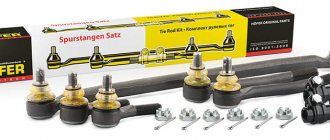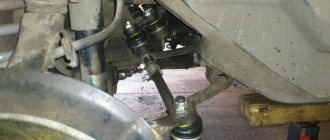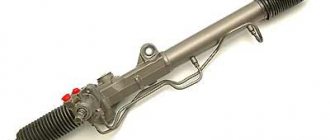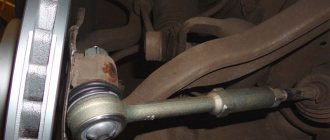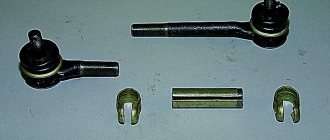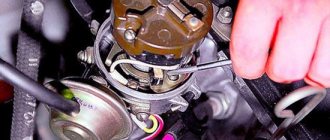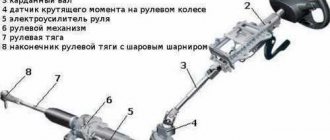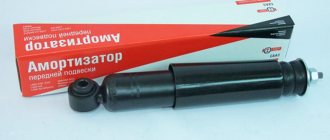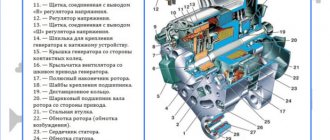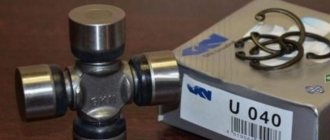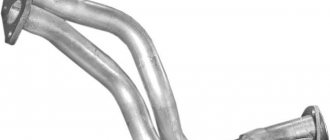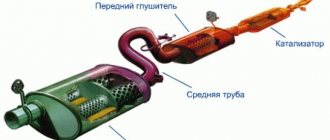Replacing steering rods VAZ 2107
On VAZ-2107 cars and other models of the “classic” series, a worm gear is used - it allows you to convert the rotation of the steering wheel into the translational movement of rods. If you suddenly notice that the play on the car has increased, this does not mean that the steering tips on the VAZ-2107 necessarily need to be replaced.
Very often the gearbox elements wear out and the adjusting bolt has to be tightened. To do this you need to perform the following manipulations:
- Place the car on a level surface and have an assistant drive. Without it, it will be difficult to cope with the work.
- Loosen the nut that secures the steering gear adjustment bolt.
- An assistant should rotate the steering wheel left and right by 10-20 degrees, no more. The faster he does this, the easier it will be for you to tighten the bolt.
- Using a wide flathead screwdriver, tighten the bolt until the free play of the steering wheel decreases.
- Hold the bolt with a screwdriver and tighten the nut.
Be sure to check the presence of oil in the gearbox housing: if it is not enough, add more. It is recommended to use TM-4 transmission oil.
Other causes of backlash
But if the play has changed insignificantly, it is recommended to check all other suspension and steering components. The reason that the free play of the steering wheel increases may be:
- Destruction of ball joints on suspension arms.
- Excessive wear of the silent blocks, which are located where the levers are attached to the body.
- Wear of VAZ-2107 steering tips. You can do the replacement very quickly with your own hands; it will be more difficult to adjust the camber and toe angles.
- Wheel bearing failure.
- Destruction of the pendulum arm located on the right side of the car.
The cost of the tip on the VAZ-2107
Before replacing, you should buy both tips - you can change one, but it does not make sense, because such a partial replacement will accelerate the wear of the remaining part. When choosing a spare part, focus on the middle price segment.
Too expensive parts are a common overpayment for an advertised product. A tie rod end, the price of which is the lowest on the market, most likely will not meet the high quality requirements for such an important component in a car.
The average cost of high-quality internal tips is about 600 rubles per pair. External tips are a little cheaper and will cost you an average of 550 rubles per set.
Checking the condition of parts
The presence of play in the connection must be checked during each maintenance of the machine. To do this, it is quite enough, with the suspension loaded with the weight of the car, to forcefully shake the steering rod with one hand and hold it on the tip with the other hand. If there is wear, you can clearly feel the play of the ball pin.
You can use a lever (mount), but there is a danger of mistaking the normal play of the spring-loaded pin for wear. Diagnostics by rocking the wheel has the same potential for errors; in this case, play will be selected in other parts and masking knocks will occur.
Replacing rods on VAZ 2101-VAZ 2107
Note! Together, the rods are called “Trapezoid” for short, so in some cases it is more profitable to completely replace the trapezoid than just one part. Sometimes, replacing a trapezoid is cheaper than replacing the parts separately.
Our instructions show the replacement using the example of one side rod; the rest are replaced in the same way.
Removal
1) First remove the wheel from the side where you are going to replace it. (Found difficulties? – read the article: “Replacing a wheel on a VAZ”)
2) Next, using pliers, unclip the ball joint pin nut.
3) After the cotter pin is removed, use a 22mm wrench to unscrew the pin securing nut.
4) Now, taking a special puller in your hands, install it as shown in the photo below, and after installation, start tightening the nut present on the puller. The finger should come out of the fist lever.
Note! If you don't have a puller, take a hammer and give it a few sharp blows to the fist lever and continue hitting until the finger indicated by the red arrow comes out of the lever ear! (You need to hit the lever along its axis).
If you have difficulty removing the pin, try applying some penetrating lubricant like WD-40, it should help and make it easier to remove the part.
5) Then do exactly the same procedure for pressing out the pin, but now press out the inner joint pin, indicated by the red arrow.
6) After all operations are completed, remove the steering rod from the machine.
Installation
Installation of a new rod is carried out in the reverse order of removal.
Note! The new part must be installed exactly the same length as the old one, otherwise the wheel alignment will be disrupted!
It is recommended to adjust the wheel alignment of the car after installing new spare parts! (read details in the instructions: “Adjusting wheel toe”)
Assembly of the unit
After removing the old rods, take a tape measure and measure their length. The problem is that you will have to adjust the wheel alignment - you won’t be able to do this yourself, it’s better to go to a service station and do diagnostics on a computer stand. After replacing the steering tips of a VAZ-2107, even if you have achieved the same length with the new elements, it is necessary to carry out diagnostics. Otherwise, when driving, tire wear will occur much faster.
Installation of new tips is carried out in the reverse order. Insert the ball pins into the steering knuckles and holes in the bipod, tighten the nuts and secure their position with cotter pins. It is advisable to purchase new cotter pins, as old ones are usually covered with a layer of dirt and rust.
Working method
You need to do the following:
1. Hang up the car and remove the wheel, not forgetting to install a reliable safety stand.
2. Clean the parts with a wire brush and spray the joints with a penetrating fluid such as WD-40 or equivalent. These are mixtures of white spirit with anti-corrosion and lubricating additives.
3. Loosen the nut securing the pin and the locking connection of the toe adjustment unit. One turn is enough. It is better to go through the thread of the pin nut several times until it rotates freely.
4. Install the puller onto the ball joint. Pullers come in different designs; it is most convenient to use a device in the form of a wedge fork; a couple of strong blows to its end are enough. The screw puller does not always cope on its own; it needs help with a sharp blow of a hammer on the bipod of the steering knuckle.
5. In the absence of a puller, you can create tension in the connection using the same pry bar, and then apply sharp blows to the edge of the bipod. The finger will detach with a characteristic click. All that remains is to unscrew the threaded end of the rod and install a new one.
The disadvantage of such a simple replacement is the need to immediately carry out operations to adjust the wheel alignment angles, as they say, wheel alignment. We must remember that replacing the tip does not affect the camber in any way, only the toe-in of the wheels changes.
If you approach the work carefully, have a sufficiently large caliper or tape measure, and understand the principles of toe adjustment, then additional costs can be avoided.
To do this, you need to perform the following operations with the highest possible accuracy:
1. Before starting to loosen the nuts, make two marks. The first should be located exactly in the center of the circle of the back of the ball joint. There are usually ring stampings or rolling. Their center must be calculated, at least using a caliper. In the found center, it is advisable to make a small depression with a light blow of a sharp core. Carefully check to see if there is any slight shift of the mark from the center. Repeat the procedure on a new tip.
2. On the steering rod, from the inside of the threaded connection, apply an annular mark lying exactly in a plane perpendicular to the axis of the rod. Smooth and neat.
3. Using a caliper or tape measure, measure and record the distance between the applied marks.
After installing the new tip, rotate the adjusting connection to achieve the same result. Lock the threads.
Despite the possibility of preserving the previously existing toe angles in this way, it will still be safer and calmer to visit the stand. The toe-in angle is quite accessible for measuring in a garage yourself; you can find various techniques in numerous tips from home craftsmen for repairing their own cars.
DIY car suspension diagnostics
Suspension boots, bushings and silent blocks
| To determine the condition of the covers, you need to feel it with your hands. |
| These cases with deep cracks are not yet worn out, but their service life is almost running out. If you replace them now with new ones, then this cheap part will protect much more expensive ones from damage. |
| If the protruding edges of the rubber bushings of the rods, suspension arms or shock absorber eyes are cracked, then it makes sense to replace them |
| If the pin has moved from the center of the eyes to the edge, then the rubber bushing is badly worn or torn, so in this case only replacement with a new one is required. |
| To determine the wear of the silent blocks (these are rubber-metal hinges) of the suspension arms, you need to use a pry bar or a crowbar so that there is enough force to move the arm relative to the body. If there is play or a knock is heard, then it’s time to change the silent block. The same technique works for other hinges. In this case, the condition of the silent blocks cannot be determined with bare hands. |
xn--2111-43da1a8c.xn--p1ai
Why did it happen so?
Perhaps the automatic requests do not belong to you, but to another user accessing the network from the same IP address as you. You need to enter the characters into the form once, after which we will remember you and be able to distinguish you from other users exiting from this IP. In this case, the page with the captcha will not bother you for quite a long time.
You may have add-ons installed in your browser that can make automatic search requests. In this case, we recommend that you disable them.
It is also possible that your computer is infected with a virus program that is using it to collect information. Maybe you should check your system for viruses.
If you have any problems or would like our support team, please use the feedback form.
From my own experience and reviews of older people, the conclusion suggests itself that tie rod ends serve much less. What does this mean for the car owner?
Long tie rod end
Let's try to figure out the causes and malfunctions of steering rods. The steering linkage of VAZ 2101 - 2107 cars is quite simple in structure, a cast body into which a metal pin is inserted, it is surrounded by plastic in which it tends to rotate. On top, this small and simple mechanism is covered with a rubber boot.
The structure is very simple, but the responsibility placed on these parts is very great - as soon as a finger breaks away from the body, an accident is inevitable. The wheel will simply become uncontrollable. How to recognize and eliminate a malfunction in time?
Design features and device
Steering nozzles are constantly subjected to high loads, so they have a simple and durable design, the operation of which is based on the principle of ensuring interconnection and redistribution of force between the elements of the vehicle control system. Simply put, they act as a link between the steering gear and the steered wheels, providing the required angle of rotation.
The design of the tips is represented by the following parts, each of which performs its own functions:
- The body in the middle of which is the axle shaft.
- A fastening element made in the form of a ball pin with a threaded connection.
- Teflon liner that fixes the finger in the seat and prevents it from moving. This ensures a reliable connection between the tip and the steering knuckle.
- Ball stud fastening nut.
- A protective housing cover that does not allow foreign particles to penetrate inside the ball joint of the part, protecting it from damage.
- Neoprene cover to protect the mechanism from the pin side.
- Retaining ring for the cover to secure it.
- A spring connecting the body of the part to the cover.
Almost all parts have a similar structure, although they can differ only in their sizes (depending on the model of transport equipment) and the materials used to manufacture their component elements.
Removing the tips
All work must be performed with the vehicle parked on a level surface and with wheel chocks under the rear wheels. It is also advisable to turn on first or reverse gear - this eliminates the possibility of rolling away when carrying out repairs. Almost identical manipulations must be performed when replacing the short steering end of the VAZ-2107 and the long rod. The design of the steering linkage has two short rods and one long rod.
The short ones can be adjusted in length - for this there are special crimp clamps into which the elements are screwed. To replace the entire rod assembly you will need to perform the following manipulations:
- Place a jack under the side to be repaired, lift the car and place it on a support.
- Remove the wheel from the side to be repaired.
- Straighten and pull out the cotter pins that are located in the fingers of the tips.
- Apply a generous amount of penetrating lubricant to all threaded connections.
- Using a 19mm wrench, unscrew all the end nuts.
- Install the puller and, by rotating its bolt, remove all the rod pins one by one.
There is nothing complicated, the main thing is to make repairs easier by treating all threaded connections with lubricant. The long rod connecting the pendulum arm to the gearbox bipod is removed in the same way. But its replacement is required extremely rarely.
Tools for repairs
In order to carry out repairs yourself, you will need the following tools:
- A set of wrenches, in particular, socket wrenches and 19mm sockets.
- Jack, shoes, reliable supports.
- Specially designed tip puller. It is possible to replace the steering end of a VAZ-2107 without a puller, but it turns out to be much more difficult.
- Pliers.
- Screwdrivers.
- WD-40 lubricant.
Be sure to have a good hammer and a mounting blade - with their help, it will be much easier to pull out the fingers of the tips of their holes in the steering knuckles.
Malfunctions and replacement of VAZ 2107 steering rods at home
Steering rods are responsible for turning the front wheels, so for safety reasons they should always be kept in working order. The VAZ 2107 is equipped with an outdated rod system with hinges, which is called a trapezoid. It has a small resource, so it has to be changed often. Knowing the device and following the instructions for dismantling and reassembling, you can replace the steering rods with your own hands.
Design and principle of operation of a trapezoid
Steering rods turn the wheels in the direction in which the driver turned the steering wheel. It is located at the level of the bottom of the car under the power unit, attached from below to the side members. Consists of three rods: right, middle and left. The middle link has two hinges, the other two are prefabricated parts from a long and short part.
The trapezoid works according to the following scheme. When the driver turns the steering wheel, the gearbox shank and shaft rotate. Using a worm mechanism, the force is transferred to the bipod. It begins to turn in the right direction along with the rods. Thanks to all three rods, the front wheels turn simultaneously. Ball pins located at the ends of the rods allow the steering rods to move only horizontally.
Diagnosis of trapezium faults
During operation, the ball pins constantly rotate, the cracks wear out, and play appears. The following signs indicate tip wear:
- You can hear knocking noises from underneath the car when driving on uneven roads;
- on a flat road, the car spontaneously changes its trajectory;
- vibration is felt on the steering wheel, which is transmitted from the play of the ball pins;
- It's hard to turn the steering wheel, and you can hear a creaking sound from below.
If you need to exert significant effort to turn the steering wheel, this indicates that the ball pin is jammed in the body. In this case, it is urgent to change the part that has become unusable, otherwise the finger may be knocked out of its socket while driving, and the car will lose control. The hinges wear out faster if the boot has become unusable, causing dirt to get into the hinge joint.
Failure of steering rods is possible for the following reasons:
- Natural wear and tear. The service life depends on the conditions in which the car is operated. Usually it is 20-30 thousand kilometers, then knocking and play appear in the nodes.
- Damaged protective caps on hinges. Dirt, sand, and water get under the boot. Corrosive processes and abrasive action reduce the service life of ball pins.
- An insufficient amount of lubricant leads to increased friction and premature wear of contacting parts. Before installation, check the presence of lubricant.
- Deformation of traction as a result of hitting some obstacle on the road or hitting a bump. If the curvature is minor, you can try to equalize the draft by heating it with a gas burner.
With severe wear, play and large free play of the front wheel pair appear in the horizontal plane. To drive straight, the driver has to constantly level the car by turning the steering wheel.
Steering rod faults are diagnosed by performing the following actions:
- The machine is installed on an inspection hole.
- Having gone under the car, you need to do a visual inspection of the trapezoid, especially if there was an impact.
- The pull is taken by hand near the tip and swung in a vertical plane - down and up. If play is felt, the part must be replaced. All hinge joints are also checked.
Set
The steering rod kit includes the rod itself and the tip (hinge). There are also several other main components.
- The main one is the housing; the axle shaft is installed in it.
- There is a ball pin on which a thread is cut for tightening.
- The third component is considered to be a Teflon limiter; it prevents the ball pin from moving and fixes it in place.
In order to protect the tip from debris and early breakage, a cover is provided that closes the housing. The kit includes several more protective devices and a nut for securing.
The kit also includes a ball joint; it is installed on the steered wheels and maintains a tight grip and limits the mobility of the steering arms. The ball joint is more of a part of the suspension because it helps keep the car on the road when cornering, keeps the wheels level, and helps steer the car.
Where is the trapezoid located?
The steering tips and rods are located in the lower part of the engine compartment, in close proximity to the interior partition. You can see them on a lift or overpass, or when turning the steering wheel to its extreme position. The design of the trapezoid consists of the following elements:
- Two lateral rods (left and right short).
- One medium pull.
- Tips – total quantity 6 pieces.
The design also contains a pendulum lever - it is installed on the right side in the engine compartment.
How to unscrew the steering wheel nut
If there is a broken thread that cannot be unscrewed, there are three ways:
- You shouldn’t immediately take a radical approach to this matter; perhaps not everything is as bad as you think and just simple manipulations are enough. First, let's clean the entire surface on which we will work with a wire brush and drop a little penetrating lubricant. If you do everything described above, then there is a chance that a regular spanner will help you to unscrew a bolt or nut with torn edges. If not, there are other ways. You can try to simply tap the ill-fated object (but not too hard!).
Lubricating a soured nut with WD-40
How to unscrew a bolt or nut with broken edges? Of course, a gas wrench will help you a lot in this case. This is truly a magical tool. This tool, of course, requires a lot of space since it is very large, but at the same time it is able to hold even the most even objects, which helps a lot in this problem.
In those equally frequent cases when a gas wrench will not help, but the nut (or bolt) is large enough, an angle grinder will come to the rescue. You can simply take and carefully cut the edges, which will be smaller than those that have been erased. Four of these newly cut edges will be enough; there is no need to try to cut out all six. After this, the nut (or bolt) can be easily unscrewed with a socket or socket wrench, or using a gas wrench for greater confidence in a positive outcome (it is not recommended to touch the open-end wrench). You can also restore the edges using a file, although this, of course, takes more time.
Cutting the nut thread with a grinder
